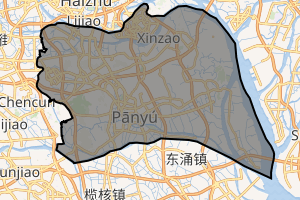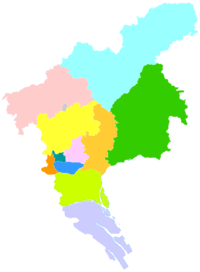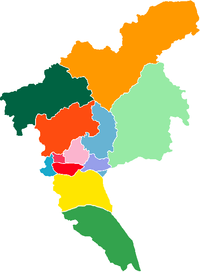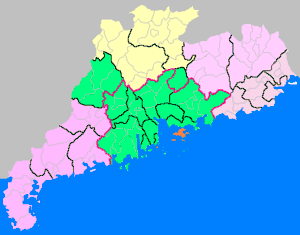Panyu District
Panyu, alternately romanized as Punyu,[lower-alpha 3] is one of 11 urban districts of the prefecture-level city of Guangzhou, the capital of Guangdong Province, China. It was a separate county-level city before its incorporation into modern Guangzhou in 2000. The present district covers an area of about 530 square kilometres (200 sq mi).
Panyu 番禺区 | |
|---|---|
District | |
Shiqiao Subdistrict | |

| |
 Panyu in Guangzhou | |
| Coordinates: 22°56′11″N 113°23′03″E | |
| Country | People's Republic of China |
| Province | Guangdong |
| Sub-provincial city | Guangzhou |
| Area | |
| • Total | 530 km2 (200 sq mi) |
| Population (2010 census) | |
| • Total | 1,764,869 |
| • Density | 2,245/km2 (5,810/sq mi) |
| Time zone | UTC+8 (China Standard) |
| Postal code | 511400 |
| Area code(s) | 020 |
| Website | www |
| Panyu District | |||||||||||||||
|---|---|---|---|---|---|---|---|---|---|---|---|---|---|---|---|
| Chinese | 番禺 | ||||||||||||||
| Guangdong Romanization | Pun1-yu4 | ||||||||||||||
| Hanyu Pinyin | Pānyú[lower-alpha 1] | ||||||||||||||
| Postal | Punyu | ||||||||||||||
| |||||||||||||||
Geography
Panyu lies at the heart of the Pearl River Delta, its boundary straddles from latitudes 22.26' to 23.05', and sprawls from longitudes 113.14' to 113.42'. Facing the Lion Sea in the east and the estuary of the Pearl River in the south, its eastern border is separated from the Dongguan by a strip of water, and the western border of Panyu is adjacent to the cities of Nanhai, Shunde and Zhongshan, while it abuts the downtown of Guangzhou in the north. The site of the People's government of Panyu is Shiqiao which is 17 kilometres (11 mi) from downtown Guangzhou and 38 and 42 nautical miles (70 and 78 km) from the cities of Hong Kong and Macao respectively. Shiqiao may have been called "Stone Bridge town," but because of war, the characters changed, so Shiqiao was rewritten using the characters for "city" and "bridge."
History
The Chinese settlement at Panyu was established by the Qin armies under Zhao Tuo during their first failed invasion of the Baiyue in Guangdong in 214 BC. There are at least 11 separate theories on the etymology of the name.[2] Upon the fall of the Qin, Zhao Tuo established Panyu as the capital of his kingdom of Nanyue in 204 BC. Archaeological evidence shows that it was a burgeoning commercial center: among the present material object remnants, there are those of Southeast Asian, Indian, and even African origin.[3]
Yuexiu District, most of Baiyun and Huangpu Districts, and parts of parts of Liwan, Haizhu, and Tianhe Districts were originally part of Panyu County but were ceded to Guangzhou as it expanded. On 20 May 1992, Panyu County was upgraded into a county-level city and, on 21 May 2000, Panyu was fully converted into a district of Guangzhou. By 28 April 2005, the southern part of Panyu was split off as the new Nansha District. On 30 September 2012, three southern towns of Panyu—Dongchong, Dagang, and Lanhe—were removed to Nansha's jurisdiction.
Administrative divisions
.png)
Panyu district administers ten subdistricts (街道) and six towns (镇).[4] The district executive, legislature and judiciary are based in the Shiqiao, together with the CPC and PSB branches. On 1 December 2012 three towns (Dongchong, Dagang, & Lanhe) were transfer to Nansha District.
| Name | Chinese (S) | Hanyu Pinyin | Canton Romanization | Population (2010)[5] | Area (km2) |
|---|---|---|---|---|---|
| Shiqiao Subdistrict | 市桥街道 | Shìqiáo Jiēdào | xi5 kiu4 gai1 dou6 | 168,701 | 20.15 |
| Zhongcun Subdistrict | 钟村街道 | Zhōngcūn Jiēdào | zung1 qun1 gai1 dou6 | 104,598 | 23.41 |
| Shibi Subdistrict | 石壁街道 | Shíbì Jiēdào | ség6 big1 gai1 dou6 | 32,989 | 27.01 |
| Dashi Subdistrict | 大石街道 | Dàshí Jiēdào | dai6 ség6 gai1 dou6 | 116,107 | 19.34 |
| Luopu Subdistrict | 洛浦街道 | Luòpǔ Jiēdào | log6 pou2 gai1 dou6 | 89,294 | 25.38 |
| Dalong Subdistrict | 大龙街道 | Dàlóng Jiēdào | dai6 lung4 gai1 dou6 | 129,515 | 24.80 |
| Donghuan Subdistrict | 东环街道 | Dōnghuán Jiēdào | dung1 wan4 gai1 dou6 | 52,965 | 11.00 |
| Qiaonan Subdistrict | 桥南街道 | Qiáonán Jiēdào | kiu4 nam4 gai1 dou6 | 72,695 | 17.85 |
| Shatou Subdistrict | 沙头街道 | Shātóu Jiēdào | sa1 teo4 gai1 dou6 | 35,201 | 18.10 |
| Xiaoguwei Subdistrict | 小谷围街道 | Xiǎogǔwéi Jiēdào | xiu2 gug1 wei4 gai1 dou6 | 131,470 | 20.15 |
| Nancun town | 南村镇 | Náncūn Zhèn | nam4 qun1 zan3 | 129,076 | 47.00 |
| Xinzao town | 新造镇 | Xīnzào Zhèn | sen1 lung4 zou6 zan3 | 27,248 | 14.12 |
| Hualong town | 化龙镇 | Huàlóng Zhèn | fa3 lung4 zan3 | 53,142 | 55.70 |
| Shilou town | 石楼镇 | Shílóu Zhèn | ség6 leo4 zan3 | 90,381 | 126.50 |
| Shiqi town | 石碁镇 | Shíqí Zhèn | ség6 kéi4 zen3 | 97,434 | 71.26 |
| Shawan town | 沙湾镇 | Shāwān Zhèn | saa1 waan1 zan3 | 88,695 | 37.45 |
Transfer Towns
The following towns have been abolished, some by absorption into the Development zone of the Nansha District.
- Lianhuashan (莲花山镇)
- Xinken (新垦镇)
- Tanzhouu (潭洲镇)
- Yuwotou (鱼窝头镇)
- Huangge (黄阁镇)
- Hengli (横沥镇)
- Wanqingsha (万顷沙镇)
- Dongchong (东涌镇)
- Dagang (大岗镇)
- Lanhe (榄核镇)
Official Villages
Under its various Subdistricts and Towns (and in the one Development zone), Panyu has 305 administration villages - i.e. 305 village governments. There are other 'natural villages' (自然村) which administratively count as being in one or another of the official villages.
Economy
Statistics shows that in the year of 1998, the GDP in the district was 33.25 billion yuan, an increase of 13% over the previous year, and the GDP per capita was 35.5 thousand Yuan, an increase of 11%, compared with the previous year.
The amusement park operator Chimelong has its headquarters on the grounds of Chimelong Paradise in the district.[6]
Transportation
Guangzhou Metro Lines 2 and 3 serve parts of Panyu District. Line 2 was extended into the district in Sept. 2010. Guangzhou South Station, the main high-speed railway station serving Guangzhou, is situated within the boundaries of Panyu District.
Panyu Public Transport operates buses in the district.
Metro
Panyu is currently service by four metro lines operated by Guangzhou Metro:
- Line 2 - Luoxi, Nanpu, Huijiang, Shibi ( 7 ), Guangzhou South Station ( 7 )
- Line 3 - Xiajiao, Dashi, Hanxi Changlong ( 7 ), Shiqiao, Panyu Square
- Line 4 - Higher Education Mega Center North, Higher Education Mega Center South ( 7 ), Xinzao, Guanqiao (not open), Shiqi, Haibang, Dichong, Qingsheng
- Line 7 - Guangzhou South Station ( 2 ), Shibi ( 2 ), Xiecun, Zhongcun, Hanxi Changlong ( 3 ), Nancun Wanbo, Yuangang, Banqiao, Higher Education Mega Center South( 4 )
Tourist attractions
Major educational institutions
The Guangzhou Higher Education Mega Center includes more than ten higher education institutions.
Schools for Chinese students:
International schools:
Notable individuals
People born in or with family links to the Panyu District:
- Xian Xinghai
- Deng Shichang
- Wang Jingwei
- Guan Liang
- Henry Fok
- Wong Jim
- Patrick Tse
- Nicholas Tse
- Francis Ng
- Sandra Ng
- Lawrence Ng
- Nick Cheung Ka Fai
- Edmund Ho
- Frankie Lam
- Hu Hanmin
- Selina Chow
- Michael Hui
- Samuel Hui
- Ricky Hui
- Shih Kien
- Chen Zhizhao
- Charles Sew Hoy
- Su Ziyue
International Relations
Panyu has a cooperational agreement with:
Climate
| Climate data for Panyu (1981−2010) | |||||||||||||
|---|---|---|---|---|---|---|---|---|---|---|---|---|---|
| Month | Jan | Feb | Mar | Apr | May | Jun | Jul | Aug | Sep | Oct | Nov | Dec | Year |
| Record high °C (°F) | 27.5 (81.5) |
29.1 (84.4) |
32.2 (90.0) |
33.4 (92.1) |
34.9 (94.8) |
36.7 (98.1) |
37.5 (99.5) |
37.5 (99.5) |
36.8 (98.2) |
34.4 (93.9) |
32.6 (90.7) |
29.2 (84.6) |
37.5 (99.5) |
| Average high °C (°F) | 18.8 (65.8) |
18.7 (65.7) |
21.8 (71.2) |
25.9 (78.6) |
29.5 (85.1) |
31.5 (88.7) |
32.6 (90.7) |
32.8 (91.0) |
31.4 (88.5) |
29.0 (84.2) |
24.9 (76.8) |
20.8 (69.4) |
26.5 (79.6) |
| Daily mean °C (°F) | 14.4 (57.9) |
15.0 (59.0) |
18.2 (64.8) |
22.4 (72.3) |
25.7 (78.3) |
27.8 (82.0) |
28.7 (83.7) |
28.8 (83.8) |
27.4 (81.3) |
24.7 (76.5) |
20.2 (68.4) |
15.8 (60.4) |
22.4 (72.4) |
| Average low °C (°F) | 11.3 (52.3) |
12.4 (54.3) |
15.6 (60.1) |
20.0 (68.0) |
23.1 (73.6) |
25.2 (77.4) |
25.9 (78.6) |
26.0 (78.8) |
24.5 (76.1) |
21.5 (70.7) |
16.8 (62.2) |
12.3 (54.1) |
19.6 (67.2) |
| Record low °C (°F) | 1.9 (35.4) |
2.7 (36.9) |
3.0 (37.4) |
9.1 (48.4) |
15.2 (59.4) |
17.8 (64.0) |
21.6 (70.9) |
22.1 (71.8) |
16.5 (61.7) |
10.2 (50.4) |
5.2 (41.4) |
1.1 (34.0) |
1.1 (34.0) |
| Average precipitation mm (inches) | 41.5 (1.63) |
61.8 (2.43) |
82.7 (3.26) |
175.8 (6.92) |
266.5 (10.49) |
294.7 (11.60) |
226.4 (8.91) |
220.1 (8.67) |
171.6 (6.76) |
63.8 (2.51) |
38.5 (1.52) |
29.4 (1.16) |
1,672.8 (65.86) |
| Average relative humidity (%) | 72 | 79 | 83 | 85 | 84 | 84 | 82 | 81 | 78 | 72 | 68 | 67 | 78 |
| Source: China Meteorological Data Service Center | |||||||||||||
See also
Notes
- Often mispronounced as Fānyú.
- Often mispronounced as Fānyú.
- Panyu was also alternately romanized as Pwan-yu.[1]
References
- Encyclopædia Britannica, 9th ed. (1878), Vol. V, "China".
- 番禺求证
- Yi Song-mi Erickson, Susan N.; Nylan, Michael (2010), "The Archaeology of the Outlying Lands", China's Early Empires, p. 163.
- 番禺区. National Bureau of Statistics of the People's Republic of China. 2013. Retrieved March 17, 2014. (in Chinese)
- shi, Guo wu yuan ren kou pu cha ban gong; council, Guo jia tong ji ju ren kou he jiu ye tong ji si bian = Tabulation on the 2010 population census of the people's republic of China by township / compiled by Population census office under the state; population, Department of; statistics, employment statistics national bureau of (2012). Zhongguo 2010 nian ren kou pu cha fen xiang, zhen, jie dao zi liao (Di 1 ban. ed.). Beijing Shi: Zhongguo tong ji chu ban she. ISBN 978-7-5037-6660-2.
- "Contact Us 联系我们". Chimelong. Retrieved 2019-06-04.
长隆集团总部 地址:广州市番禺区番禺大道 [Chimelong Group Headquarters: Panyu Dadao, Panyu District, Guangzhou City] [...] 长隆欢乐世界 地址:广州市番禺区番禺大道 [ Chimelong Paradise: Panyu Dadao, Panyu District, Guangzhou City]
- http://web.gdut.edu.cn/~draw/ICGG2004/GUANGZHOU/attr_08.htm
- "Baomo Garden - Guangzhou through a lens - Cities & Towns - Newsgd".
- "World Second Night Zoo Built in Guangzhou".
- http://web.gdut.edu.cn/~draw/ICGG2004/GUANGZHOU/attr_11.htm
- "Archived copy". Archived from the original on 2011-02-10. Retrieved 2020-04-29.CS1 maint: archived copy as title (link)
- "Home". Canadian International School of Guangzhou. Retrieved 2020-05-13.
Dongyi Road, Panyu District, Guangzhou.
- "Guide for Foreigners in Guangzhou" (Archive). Foreign Affairs Office of the Guangzhou Municipal Government (广州市人民政府外事办公室). p. 32/74. Retrieved on August 17, 2015. "Guangzhou Korea School Add: Jinxiu Xiangjiang Estate, Nancun Town, Panyu District, Guangzhou"
- "Council resolution of Prague 5th district approved on April 14 2015".
External links
| Wikimedia Commons has media related to Panyu District. |
- Panyu Panyu District official website
- Photos of Panyu, courtesy of Vince K. Chan
- Panyu Travel Guide
- 'Red Diamond', on Panyu's diamond processing industry, by Venkatesan Vembu, Daily News & Analysis, 11 March 2007


